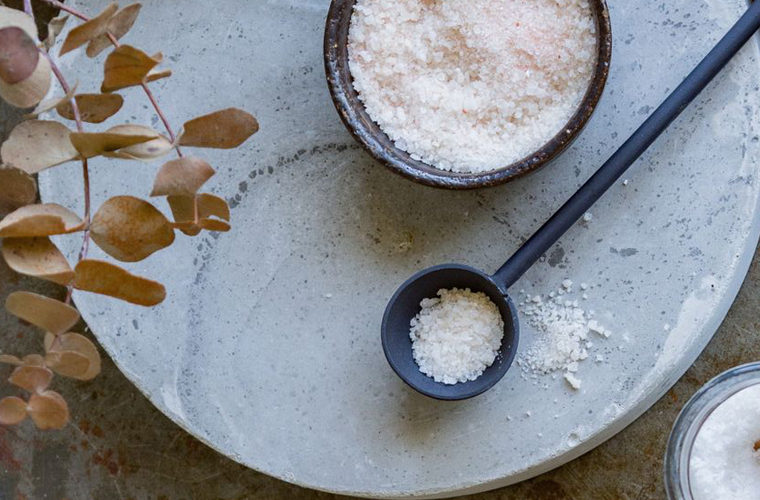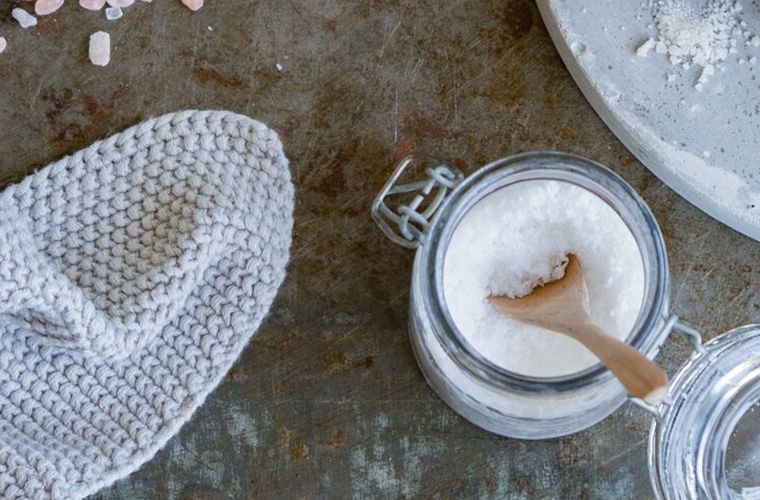What Is Magnesium Sulfate and Why Is It Sometimes Called Epsom Salt?
Posted by The Salt Box on 31st May 2018
Interest in bath salts for use in health, beauty, and sports medicine has been exploding in recent years, and if you’ve been following the chatter, it’s likely that you’ve heard two main topics of conversation: magnesium sulfate and Epsom salt. But what you may not realise is that you are actually reading and hearing about the same thing.
Why the confusion? Well, first of all, Epsom salt isn’t salt as you know it (that's sodium chloride), but rather a naturally occurring mineral compound of magnesium and sulfate. Secondly, there has been increasing interest in the powers of magnesium for overall wellbeing and recovery after sports and exercise. However, in some cases here, you may having been reading about magnesium chloride, otherwise known as magnesium flakes. It can all be a little baffling. But what’s important to remember is that magnesium sulfate and Epsom salts are the exact same thing.

When we talk about magnesium sulfate and Epsom salts, were actually talking about the same thing. And it's wonderful stuff. take a look at what magnesium sulfate can do for you.
Why Is Magnesium Sulfate Called Epsom Salt?
Like many common names for chemical compounds, there’s an interesting story behind why we call magnesium sulfate Epsom salt. As you might have guessed, Epsom salt is named after the place where it was discovered - a rural community in Surrey, near a town called Epsom.
It was first discovered in the 17th century by a farmer who noticed his cattle wouldn’t drink the water from a particular spring. Intrigued, he tried the water for himself, noting that it was very bitter, and that when it evaporated it left behind a white, flaky, salty-looking substance. He also soon found that the water had a purging effect and that his animals that bathed in the water seemed to have wounds heal faster than others.
Soon after, people began to flock to Epsom to benefit from the purgative effects of this bitter water. Some were looking to relieve the painful symptoms of gout (the swelling of joints mainly), while others benefitted from its other purging effects (that being, as a laxative). It was said to have been drunk from stoneware mugs - sometimes as many as 15 pints at a time.
The incredible substance wasn’t officially named until the 1690s when a British anatomist and physiologist named Dr. Nehemiah Grew documented these "bitter purging salts" that he found near Epsom in a book , Nature and Use of the Salt contained in Epsom and such other Waters (1697).
Grew acquired the patent for exclusive manufacturing of Epsom salt, and as more springs were discovered across England, it was soon readily available over the counter. As more and more people began to use it, more of its uses and health benefits were discovered. Later studies found that Epsom salt was in fact a compound of magnesium and sulfate, both of which are readily absorbed through the skin, thus being perfect for use in the bath. From there, its popularity and abundance grew exponentially.
What Is Magnesium Sulfate and What Can It Do For Me?
So what exactly is magnesium sulfate, and what are its uses and benefits for your body? Magnesium sulfate is an inorganic salt with the formula MgSO4. Being an inorganic salt simply means it does not contain carbon. It is most commonly found as ‘epsomite’, which is a heptahydrate sulfate mineral, but most people just call it Epsom salt.
Now, with all that technical stuff out of the way. Let’s take a look at why it’s such an incredible substance. Both magnesium and sulfate are important minerals that play a number of roles in our body. Magnesium is an essential mineral that is key to over 300 biochemical functions in the body.
When ingested (via food), or absorbed through the skin, it helps reduce inflammation, remove toxins and other heavy metals, improve circulation and blood flow, soothe skin conditions like eczema, acne, psoriasis and dermatitis, relieve joint pain, hydrate the skin and relieve bodily stress and fatigue.

Sulfate is also an essential mineral. It’s main role is to stabilise protein structures, but it also helps improve the absorption of nutrients and flush out toxins. It is component of the hormone, insulin, which is important for controlling your blood sugar levels.
When dissolved in water to use as a bath salt, magnesium sulfate has a number of health benefits. You can use it to cleanse and exfoliate your face and body, soak your feet in a salt bath to get rid of foot odour and fungus, apply to insect stings and bites to help relieve itching, and soak in to help boost muscle recovery, just to name a few.
It’s also very handy to have around the house, useful for everything from cleaning gunk build-up in your washing machine to fertilising your plants, flowers and vegetables (magnesium and sulfate are great for producing the primary nutrients needed for plants to survive). Read more about the wonderful benefits of Epsom salts here.
Magnesium sulfate is what is used in floatation tanks to make the water buoyant enough to float in. You can read more about the benefits of flotation therapy here.
How Do I Use Magnesium Sulfate
If you are looking to make the most of the wonderful benefits of Epsom salts can have on your body, there are a few ways it can be used. Both magnesium and sulfate are highly soluble in water, hence why they are perfect for use as a bath salt.
In The Bath: This is best for widespread symptoms, like sore and aching joints. Add 6-8 cups of magnesium sulfate to a warm running bath and, once dissolved, soak for around 20 minutes. If you have ongoing symptoms, repeat 3 times per week for 2-4 weeks. After symptoms subside, reduce to maintenance levels - once per week is ideal.
In a Foot or Arm Bath: This is suitable for symptoms in the extremities, such as sore feet or eczema. Grab a watertight container, fill it with warm water, and add roughly ¾ of a cup per 10 litres. Once dissolved, submerge the affected area for approximately 20 minutes. If you have ongoing symptoms, repeat 3 times per week for 2-4 weeks.
As a Body Wrap: This is suitable for localised symptoms. Dissolve in approximately ¾ cup of salt in 10 litres of warm water. Once fully dissolved, saturate a small to medium sized towel with the salted water. Cover the affected area of skin with the towel for 20 minutes.
Take a look at our range of magnesium sulfate products here!




